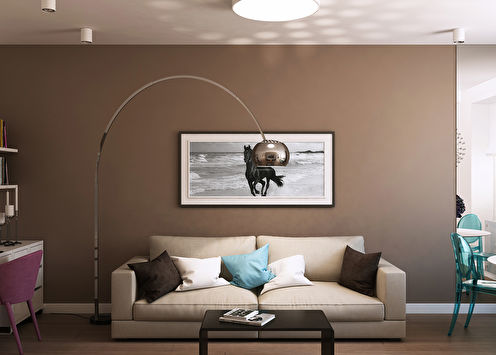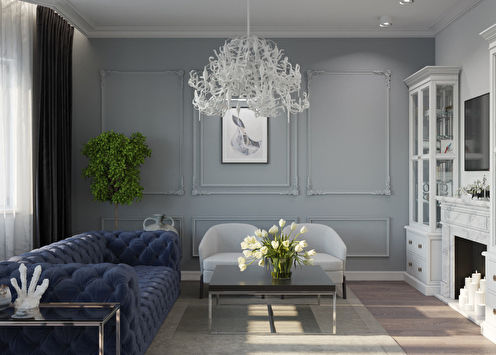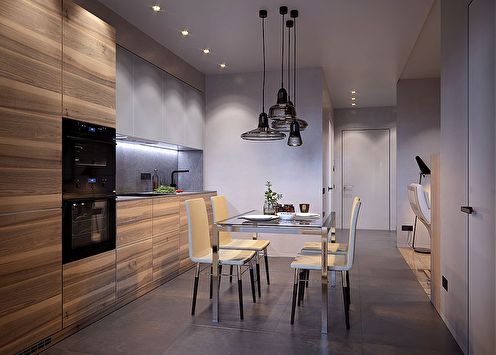
Among all the rooms in the entrance hall house, it is the heaviest of all: due to street dirt, which inevitably settles on the surfaces, frosty air that bursts into a warm environment, or shoes with heels, which creates an additional load. Under the influence of such factors, the flooring quickly erases, becomes dirty, sometimes even cracks, in other words, loses its visual and practical properties. This can be avoided by selecting high-quality tiles on the floor in the hallway, which is deservedly ranked as a list of optimal finishing solutions.
Features of choice
When choosing a material for cladding, it is necessary to focus on the requirements that this space makes. Firstly, it must have a high degree of resistance to various destructive substances: moisture, household chemicals, abrasive substances and so on. Some types of tiles are vulnerable to such effects, especially in the area of joints. Waterproof grout will help to solve this problem, as well as the use of large fragments, instead of, for example, mosaics.
Secondly, the products must be wear-resistant, not washable with constant interaction with shoes, friction, and also withstand heavy objects. According to this indicator, the tile is divided into classes, and the higher - the better for the hallway.
Thirdly, it is worth considering the risk of injury and comfort of movement. The surface should be flat, but with a low level of slip, which in glossy often increases when in contact with water.
Last, but not least, are the visual merits of the tile - does it match the design of the room, how does it fit with other compositional elements, does it highlight the disadvantages of geometry, and so on.
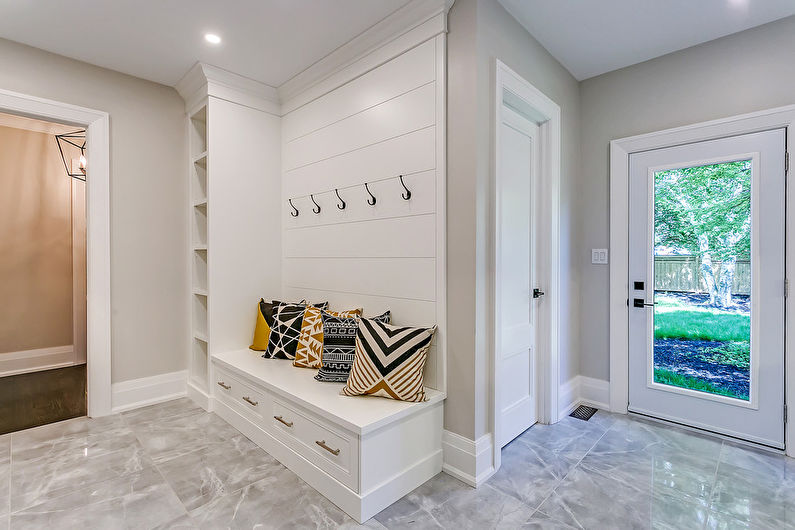
Types of floor tiles
Floor tiles are presented in several variations, which differ in composition, characteristics, design capabilities and, of course, price. Consider the main ones.
Ceramic tile
The traditional and most common form, while not only for the floor of the hallway. It is made of fired clay, which endows fragments with resistance to wear, and with it - durability. True, this does not apply to strong impacts, which can lead to the formation of cracks.
Temperature differences of ceramic tiles are also not terrible, since they usually maintain a stable cold state, which will bring inconvenience to lovers to walk barefoot on the floor.
With its help, you can realize almost any idea: whether it is colorful colors, unusual shapes, complex patterns, embossed texture or minimalistic even coverage.


Porcelain Tiles
It is referred to as extra-class products with increased strength. Ceramic granite is made from different mixtures of crushed rocks, high-quality clay, as well as natural dyes, which are presented in a wide palette of shades.
This is a low-porous material that does not absorb much moisture, unlike ceramic tiles, which are not so ideal in this parameter. At the same time, the complexity of laying does not differ much. He also copes with the rest of the requirements. The main disadvantage is the high cost.
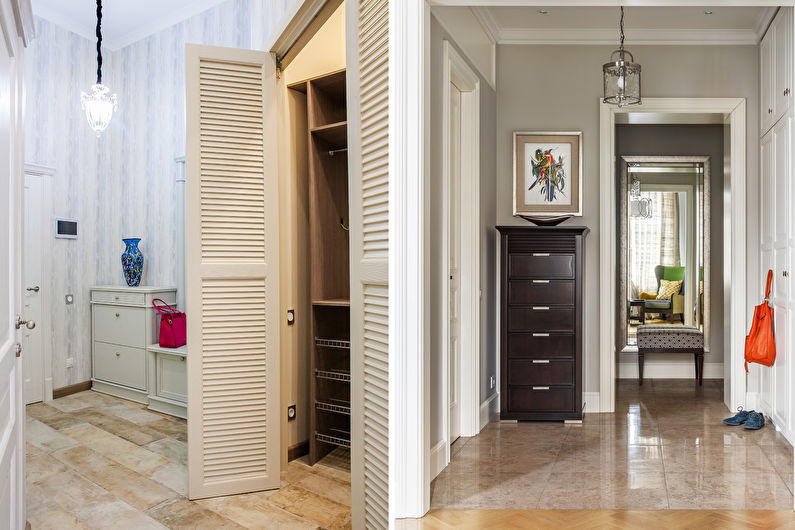

Quartz Vinyl Tile
The construction industry has introduced an improved version of the tile, which is not afraid of any temperature, load and detergent. In addition to quartz, this material includes stabilizers, plasticizing compounds, pigments and vinyl, which endows the product with strength, ductility, and a variety of shapes.
Despite the presence of components of artificial origin, quartzinyl is considered safe for human health, but in the hallway it does not play such an important role due to the occasional use of space. If necessary, you can easily replace several blocks without damaging the overall composition.
The disadvantages include the massiveness of the fragments, as well as the need for perfect alignment of the base - even minor irregularities will significantly affect the movement.
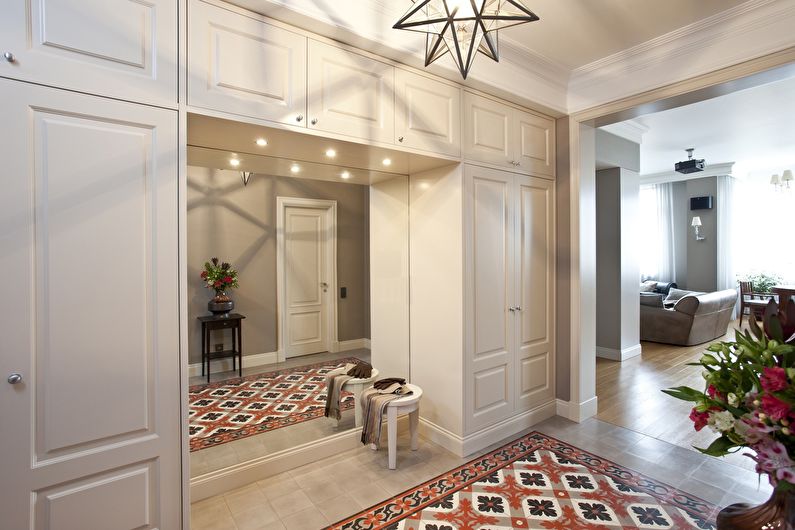
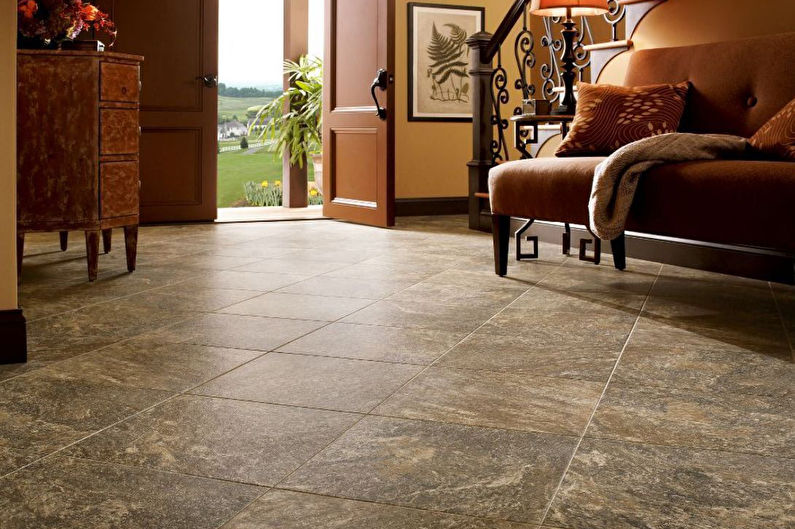
Choosing a tile design for the hallway
Technical characteristics are, of course, an important factor in the choice of flooring, but aesthetics and visual decoration of the interior are equal in position. After all, the entrance hall is the first place that visitors face at home, so every detail in it creates a certain impression.
Color variations
Any type of tile has a wide palette of colors, so here the author is limited only by style, taste preferences and the possibilities of the area.
Traditionally, light shades help to expand the room: these are white, beige, walnut, gray, as well as pastel varieties. But against this background, any pollution that appears literally every day is faster.
Unfortunately, traces of dirt will also be visible on a dark smooth floor, like any scratches. Such a gamut noticeably outlines the space, especially if it is not so much.
It is best to use muted colors with a heterogeneous texture or patterns for decoration - they look advantageous in the interior and do not seem boring. Pay attention to the tone, since cold options tend to visually move objects away, while light options, on the contrary, bring them closer.
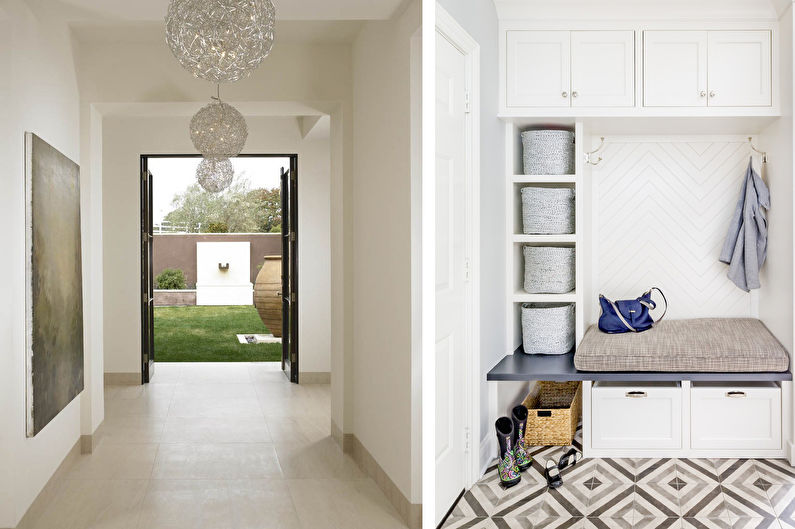
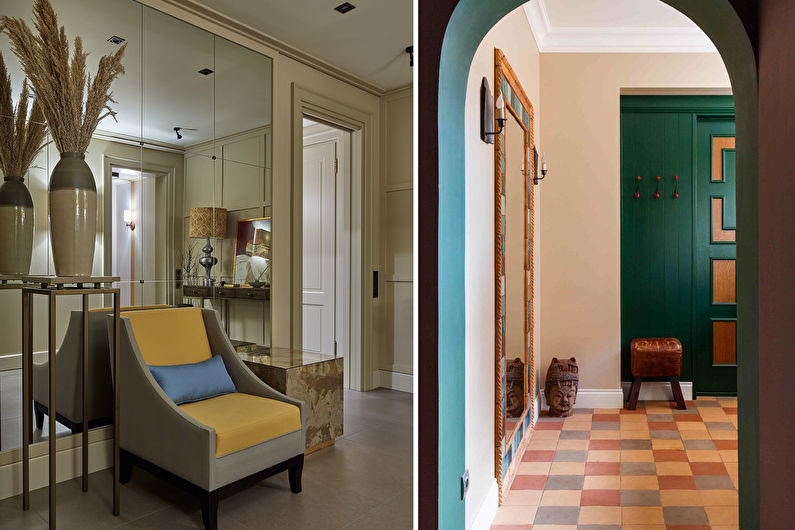
Patterns
It is not possible to put photorealistic paintings on the tile - and it’s not worth it, especially in such a secluded room. But to embody other techniques on the strength of any type of product.
It can be simple geometric shapes, ethnic ornament or floral patterns, which are made in different colors. In large hallways, you can allow to decorate the floor with a small pattern, which creates a kind of cozy atmosphere. But most often the decor is combined with a plain base, thereby balancing the bright details.
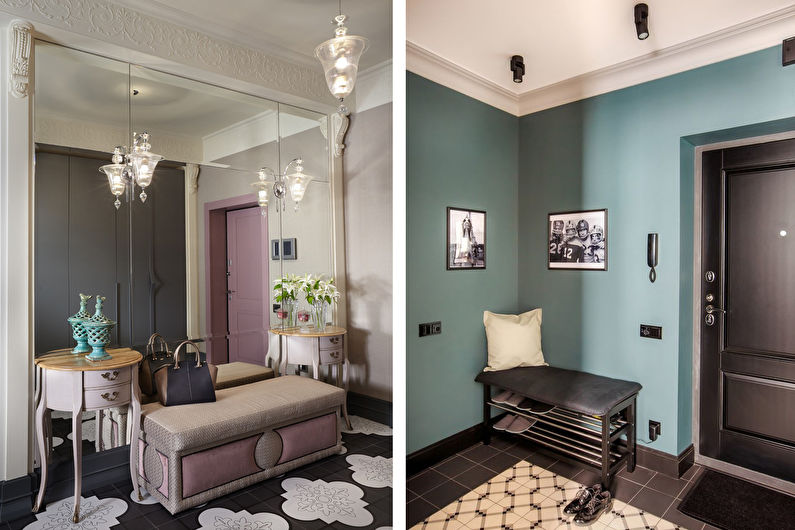
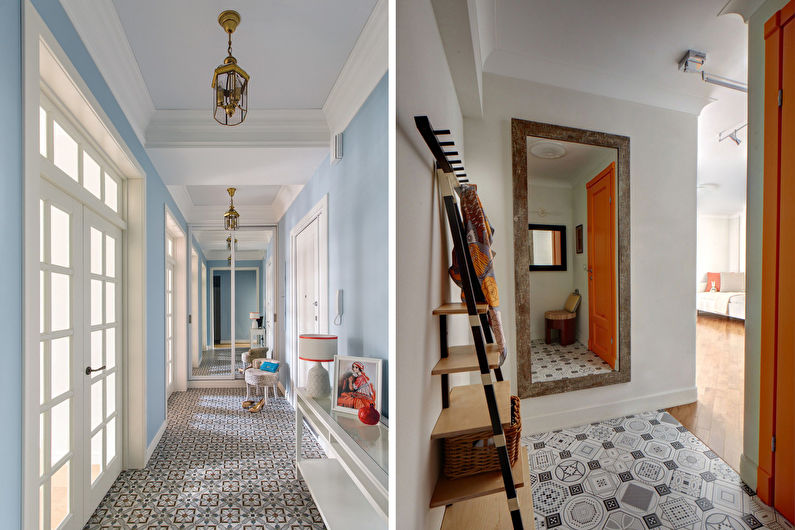
Texture solutions
If desired, you can order a finish with embossed texture, but this option is usually neglected due to the inconvenience of moving around the floor. In general, there are several types of surfaces:
- Glossy. Reflects surrounding objects and is rarely used in small hallways, despite the effectiveness of mirror surfaces in such spaces. The occurrence of any scratches is immediately evident.
- Matt. Optimal non-slip solution, on which traces of dirt are not so noticeable. Due to its low reflectivity, it reproduces color better.
- Satin. A floor with a micro-relief on which light shimmers gently, beautifully emphasizing the decor of the tile.
- Structural. It is a more budgetary and durable imitation of natural materials - wood or stone.
The most optimal are matte and satin products, mainly due to their practical properties.
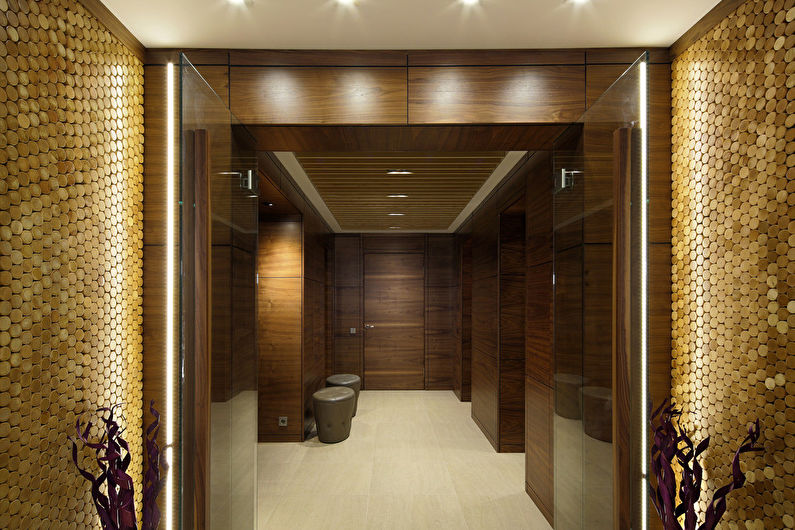
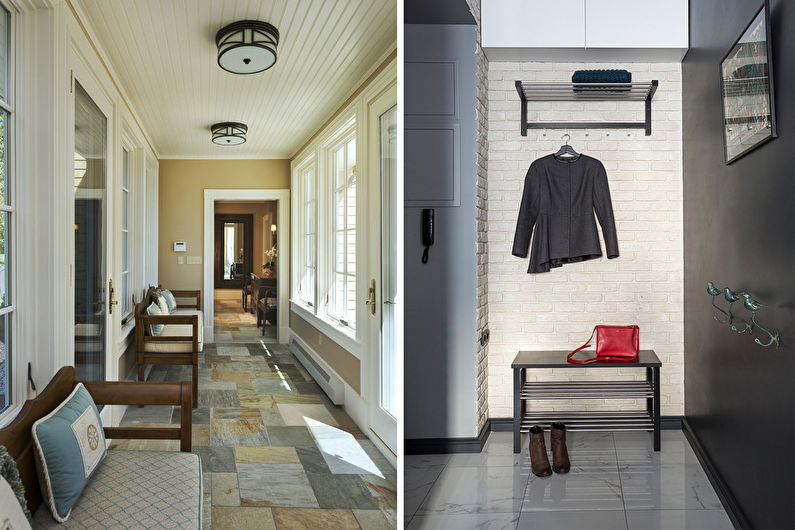
Tile size and shape
The possibilities of the tile are limited - for example, you can not "lay" the room with a continuous coating. But they still offer a certain variety.
In large hallways, you can trim the floor in large blocks that emphasize its scale. Medium details fit perfectly into a medium to small room. But mosaic fragments are more likely to be attributed to decorative techniques, therefore they are not used for finishing the floor.
Regarding the forms, we note that curly ones are rarely found in interiors. In addition to standard square and rectangular elements, diamond-shaped, round, trapezoidal or hexagonal ones can be fit - and this assortment is not limited to. For the visual effect, several species are often combined.
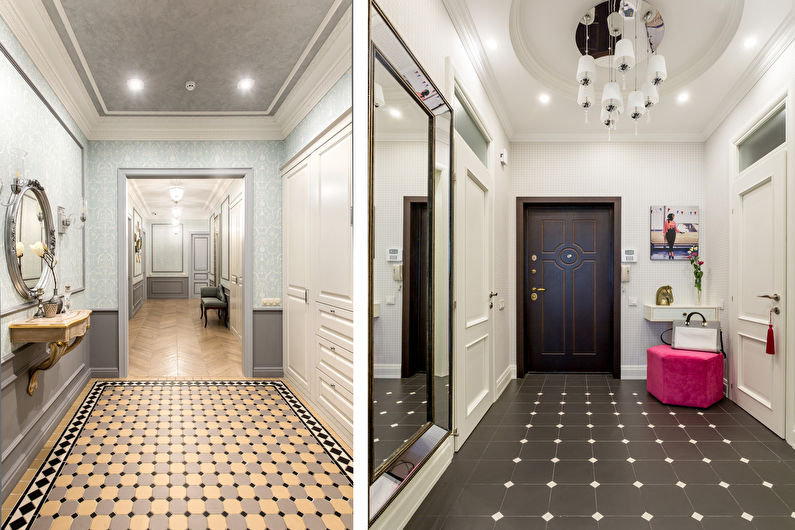
Laying Types
It is interesting to veneer the floor in the hallway will also help different ways of laying material. These include:
- Traditional direct stacking in a row;
- The diagonal option, which requires additional steps to form suitable products;
- Bricklaying;
- Parquet, which is used for tiles that simulate a wooden texture;
- Modular - a combination of tiles of different sizes;
- Carpet, involving the use of any decorative elements.
To properly arrange the floor, it is better to turn to the services of professionals.
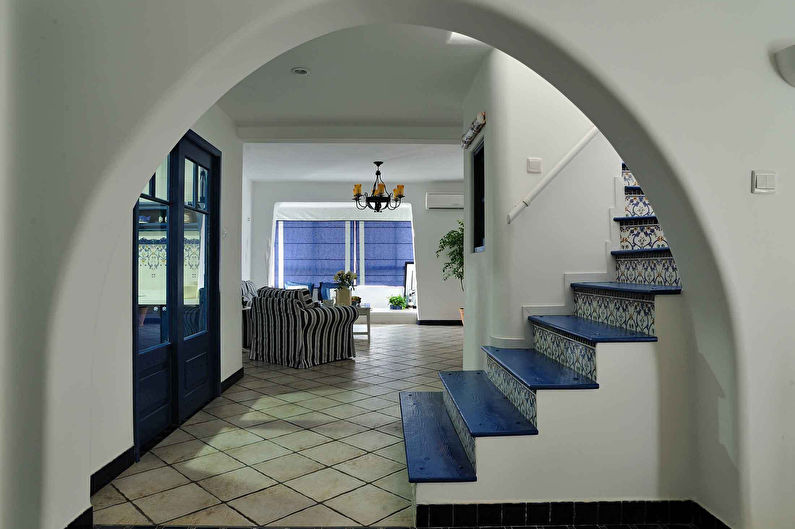

Interior Styles
There are many design options, but when you have to deal with a certain style, they often come down to several profitable solutions.
Classic style entrance hallway tiles
Floor tiles will help to realize the classics in its most luxurious interpretation, especially if the area of housing contributes to this. This is the case when the gloss will look appropriate, especially in combination with marbled porcelain stoneware or classic patterns.
In more modern interiors, you can confine yourself to a light natural finish with several decorative elements that are consonant with the color scheme.
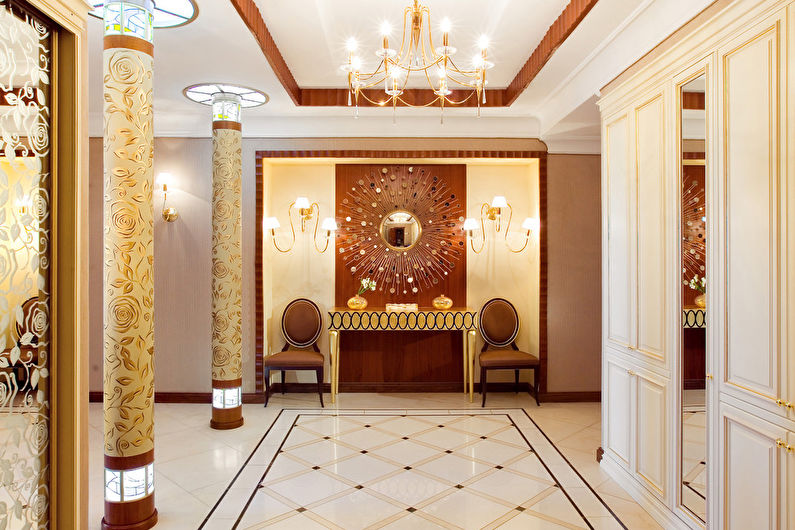
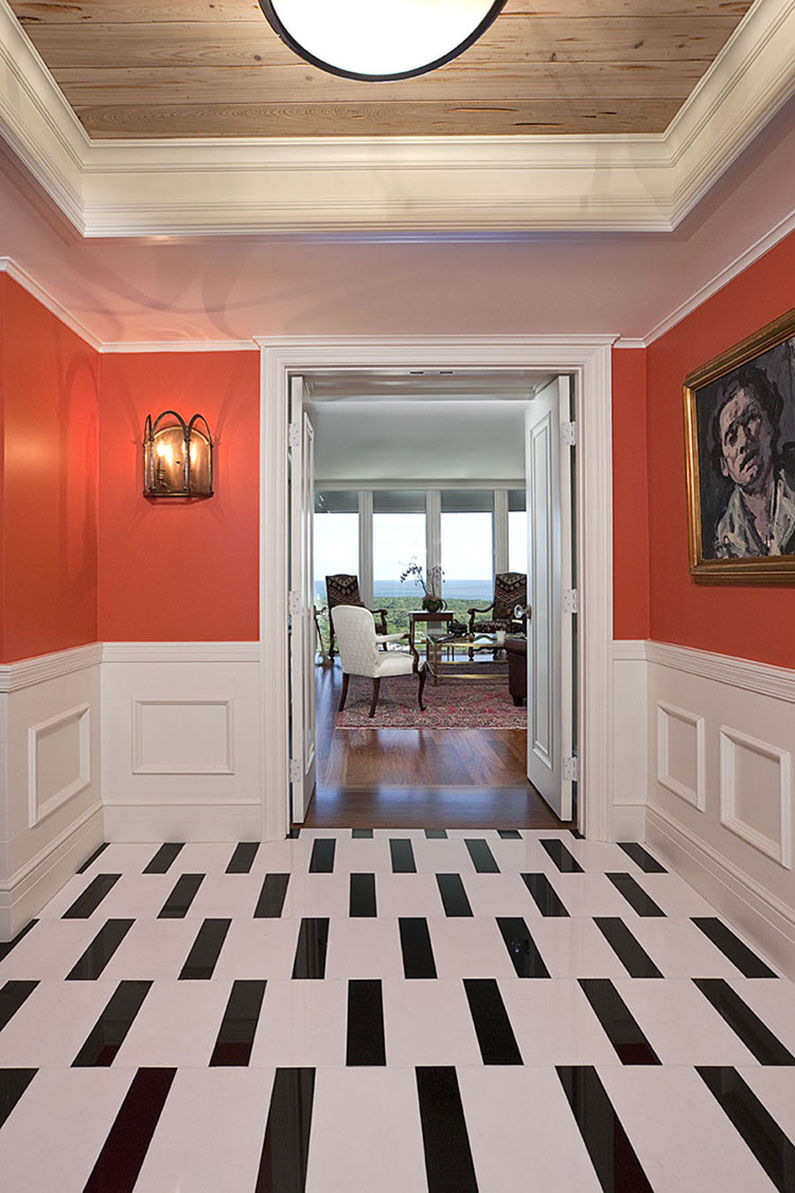
Tile for a hall in a modern style
The visual component of the direction is on a par with the practical and often draws aesthetics from it. It is necessary to focus on the convenience of the material, as well as on its compliance with the geometry of space.
Harmoniously matte floor tiles of a light gamut with a homogeneous or structural surface will fit into such a hallway. But the modern style is suitable for interesting experiments - for example, a glossy black floor surrounded by white walls.
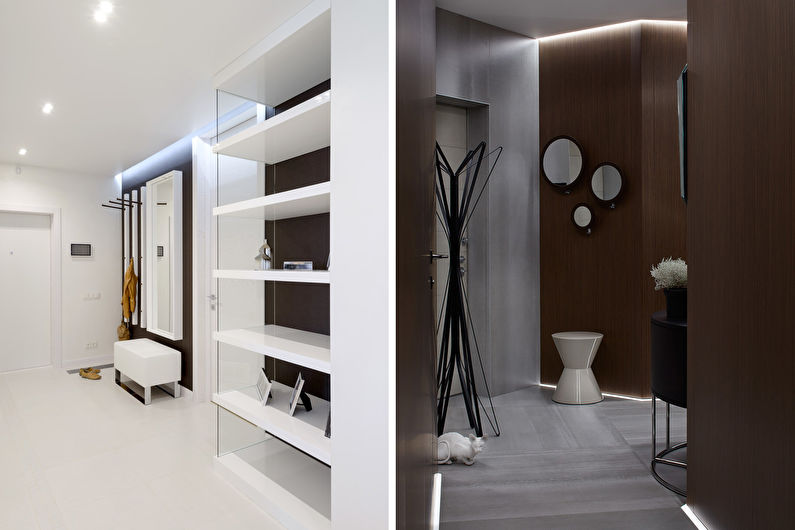

Scandinavian style hallway tiles
The dominant place in the Nordic interior is white, so you can not think for a long time and continue it at the base of the room. In addition to standard square fragments, you can pay attention to tiles of various shapes with geometric patterns, or lay it like brickwork. Natural texture coatings are also suitable for the entrance hall.
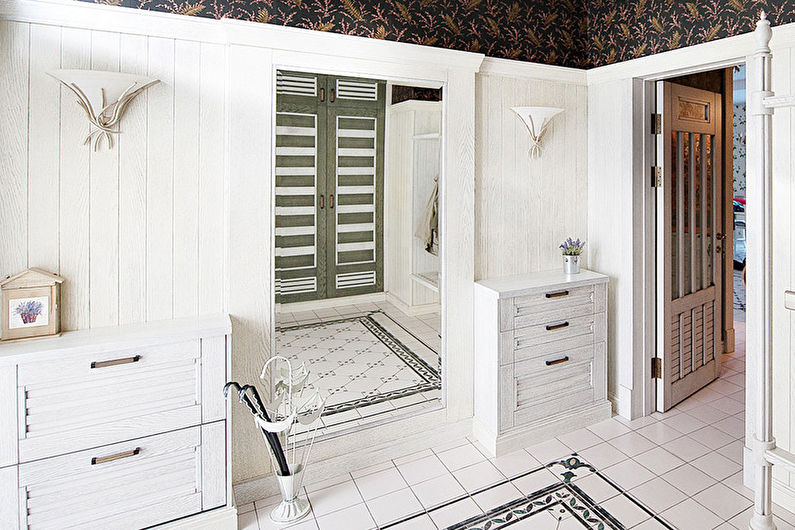
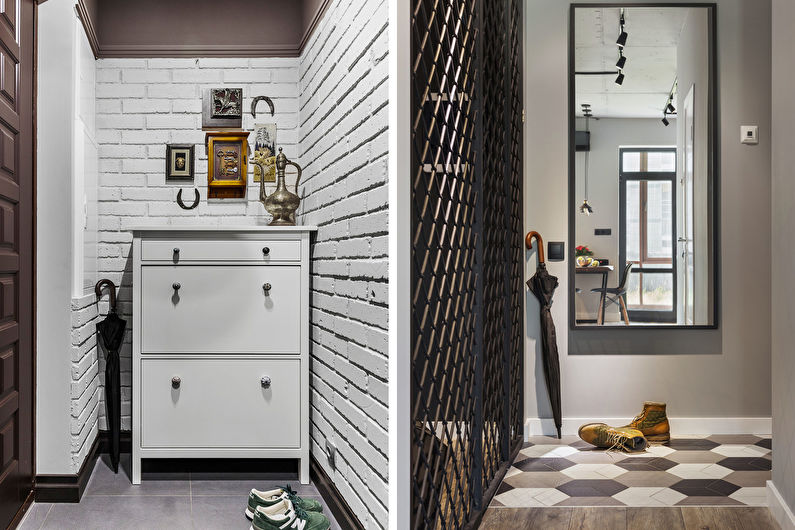
Loft entrance hallway tiles
Inspired by industrial aesthetics, the loft is the perfect “canvas” for a variety of combinations. You can buy floor tiles for wood, stone or even concrete. Against the background of brick walls, detailed fragments of different shapes look interesting, contrasting with other compositional elements.
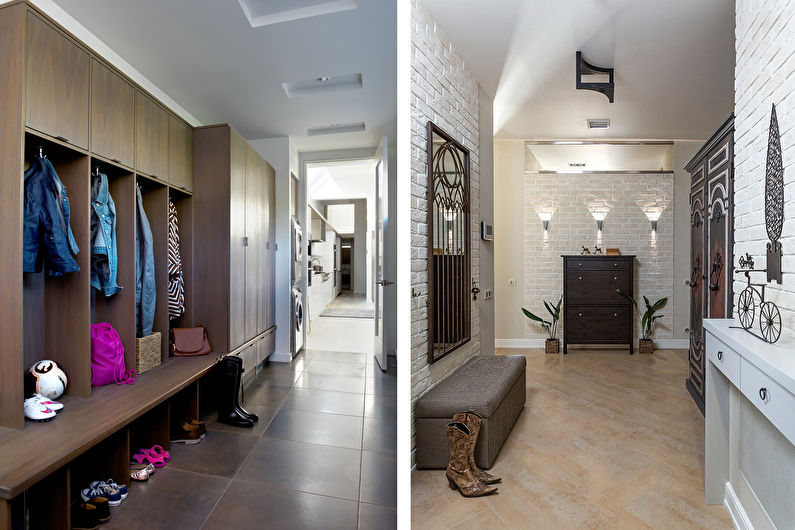
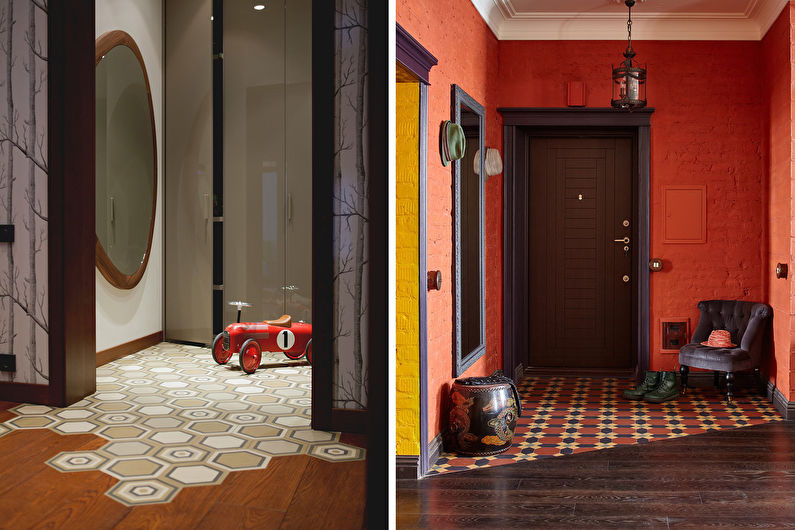
High-tech hallway tiles
Despite its commitment to high technology, hi-tech does not shy away from traditional solutions. Here you can use large solid blocks with a deep texture, matte products or those that gently reflect lighting.
The colors are strict, natural, continuing the monochrome palette characteristic of the style.
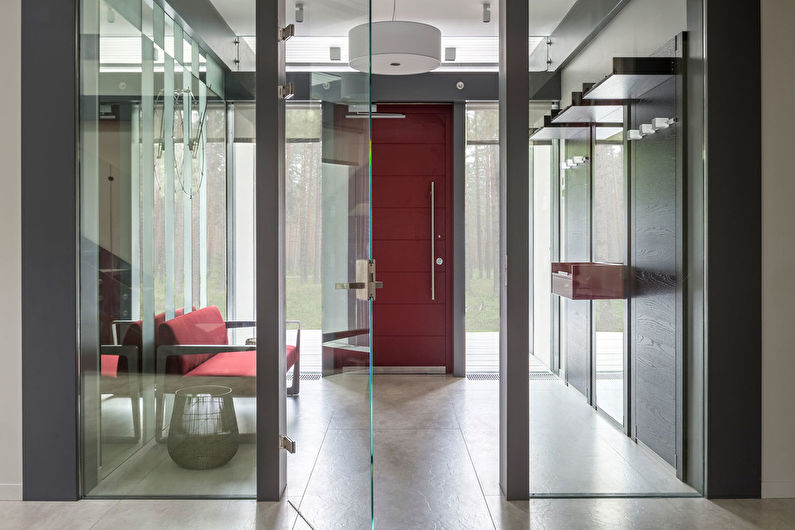
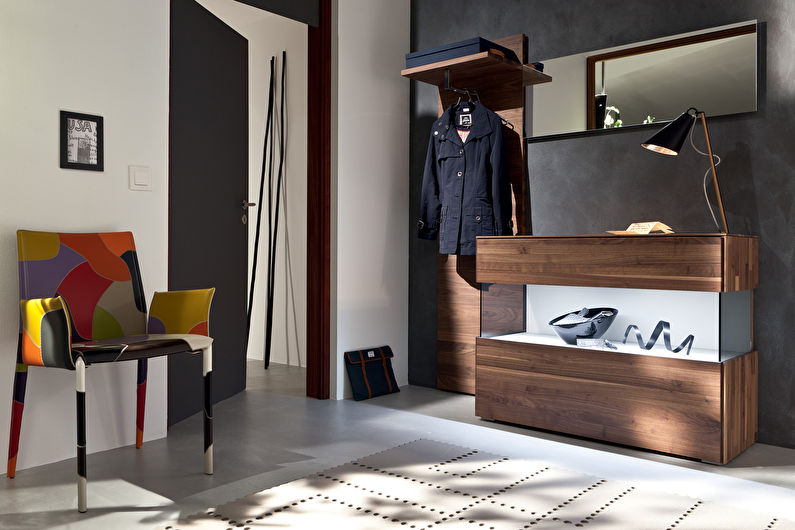
Floor tiles in the hallway - photo
Just one type of finish offers such a wide variety of design solutions: from texture to styling. In our selection of photographs, we tried to demonstrate the advantages of floor tiles in the hallway, inspiring you with new ideas. Enjoy watching!

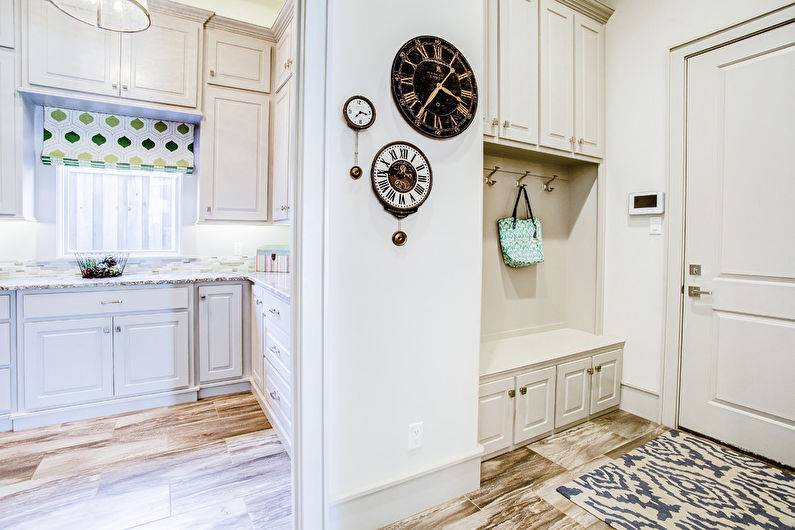
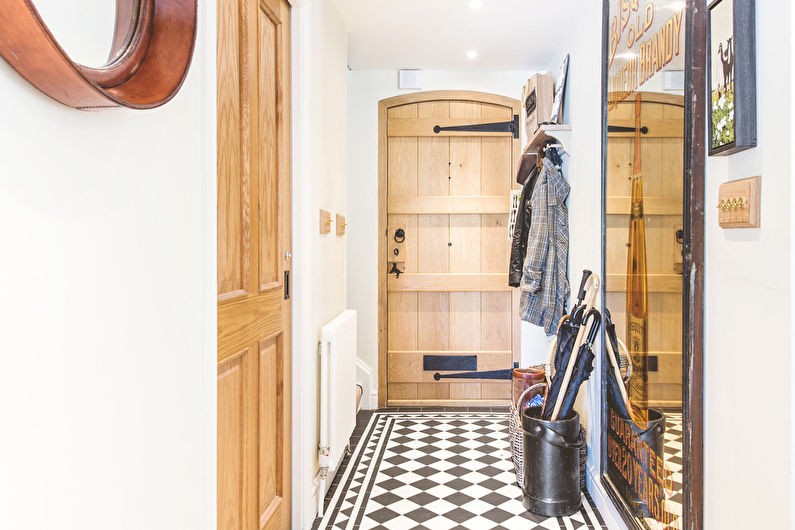
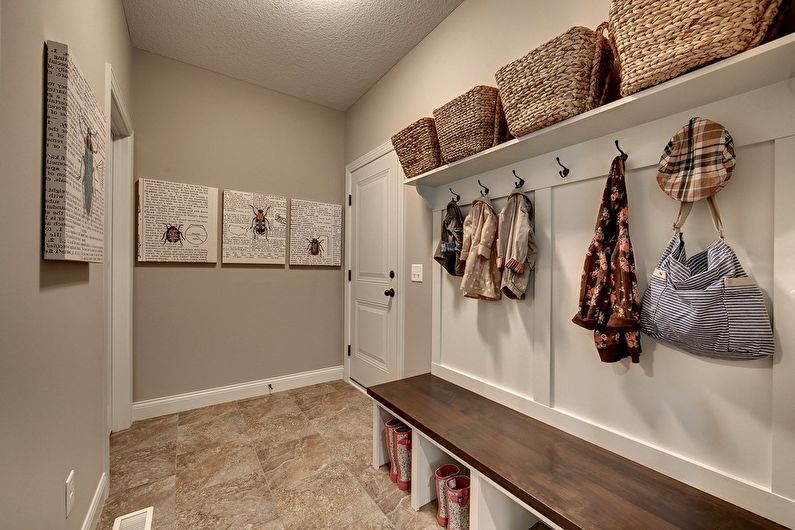
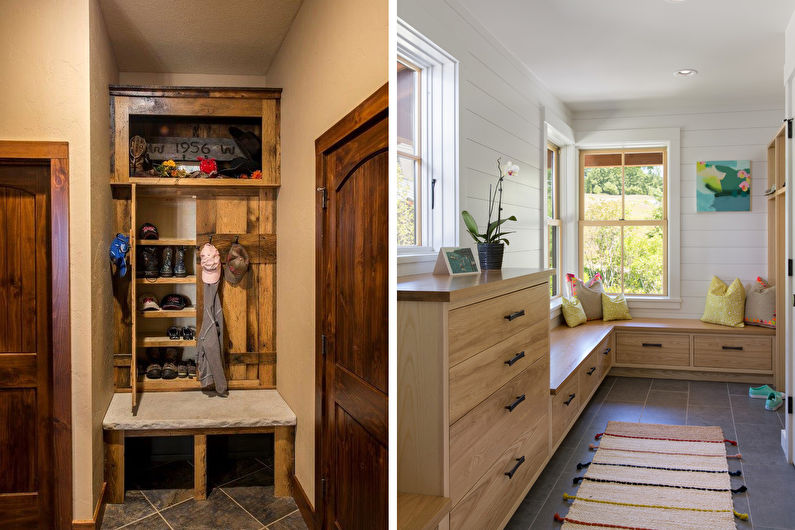
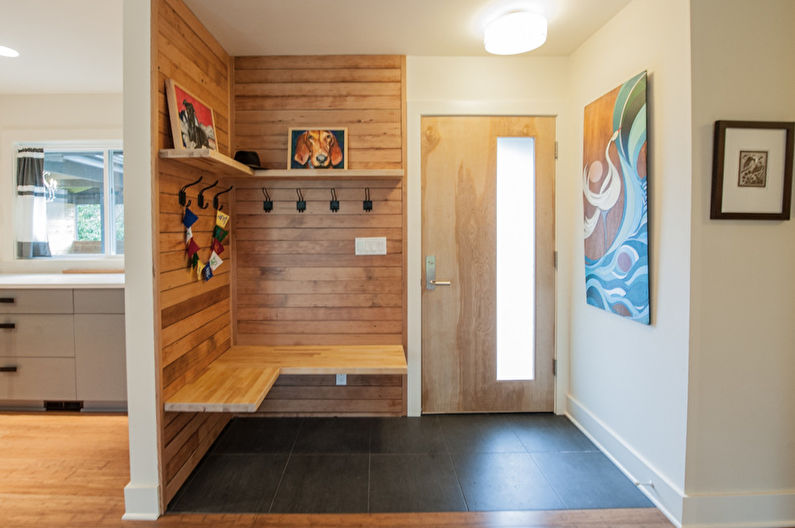
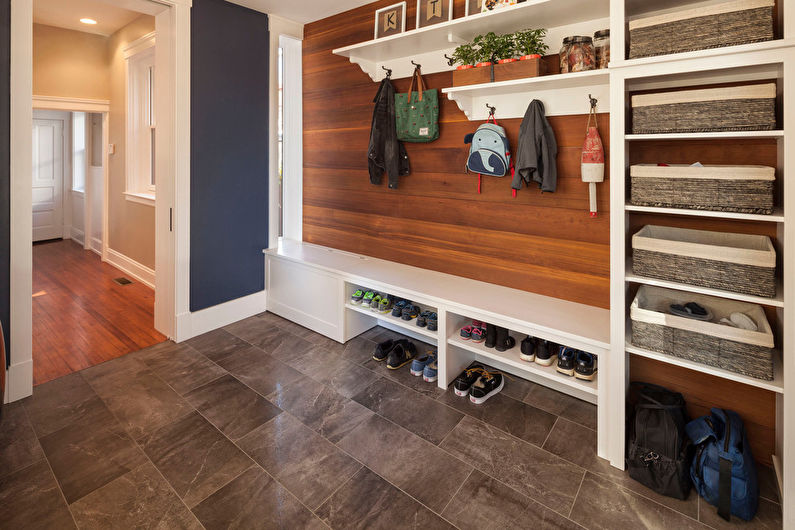
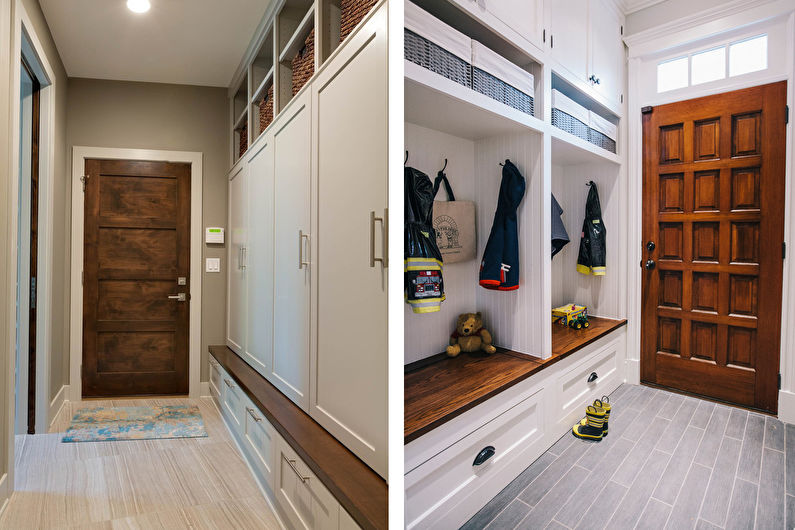
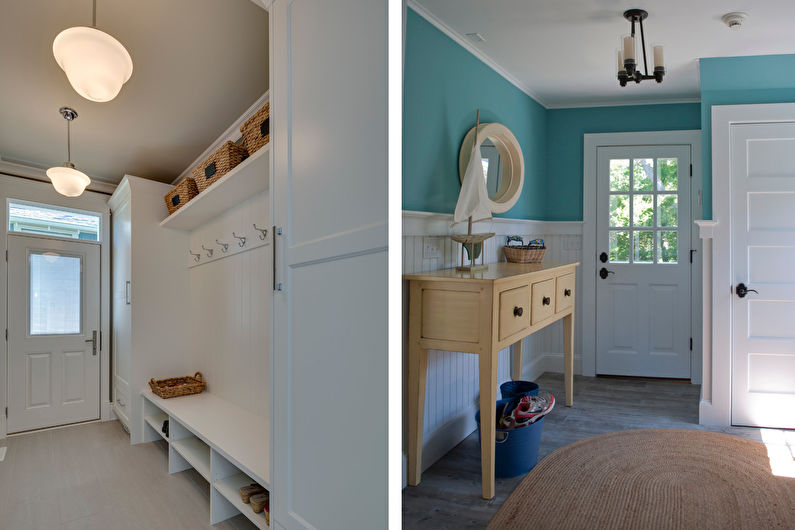
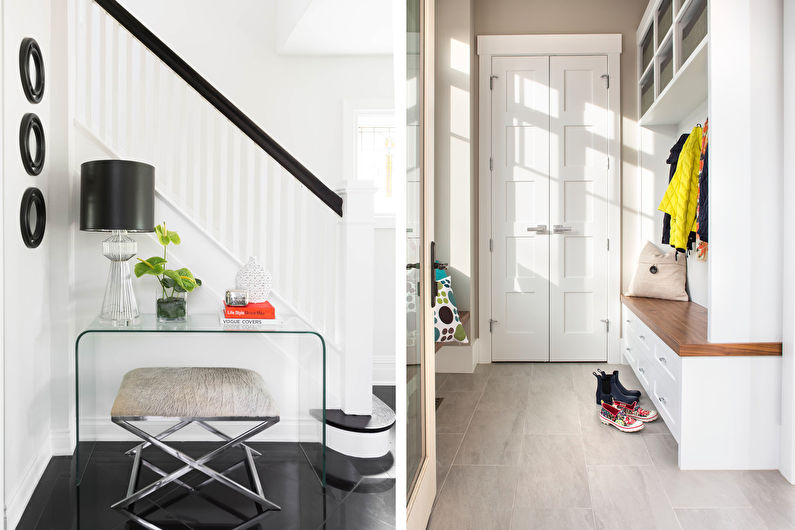
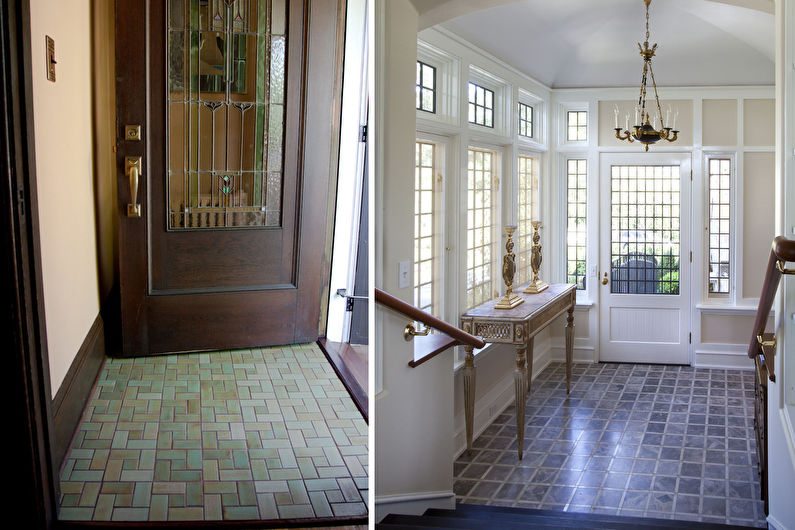
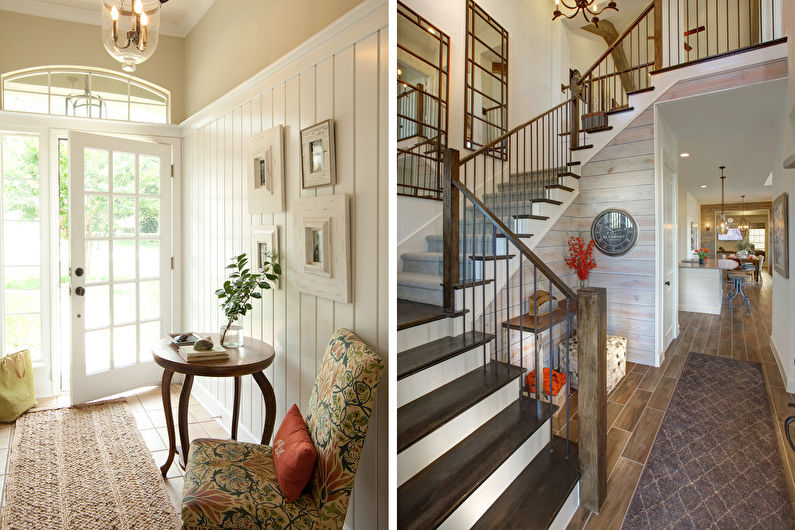
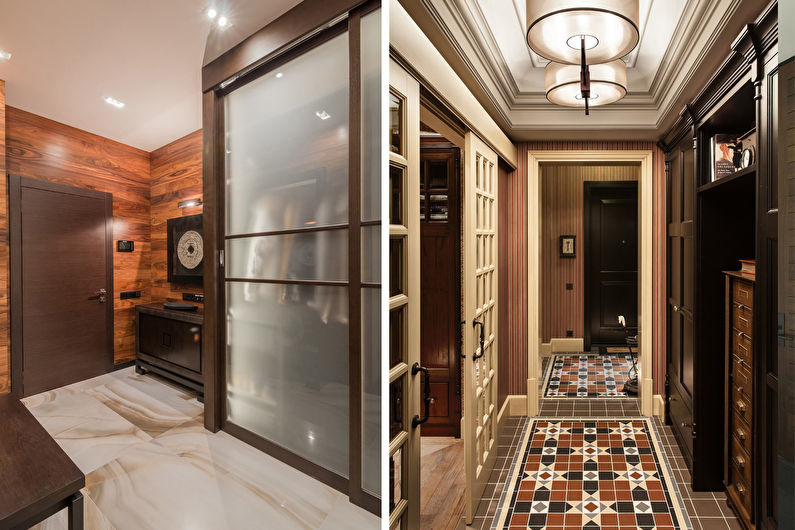
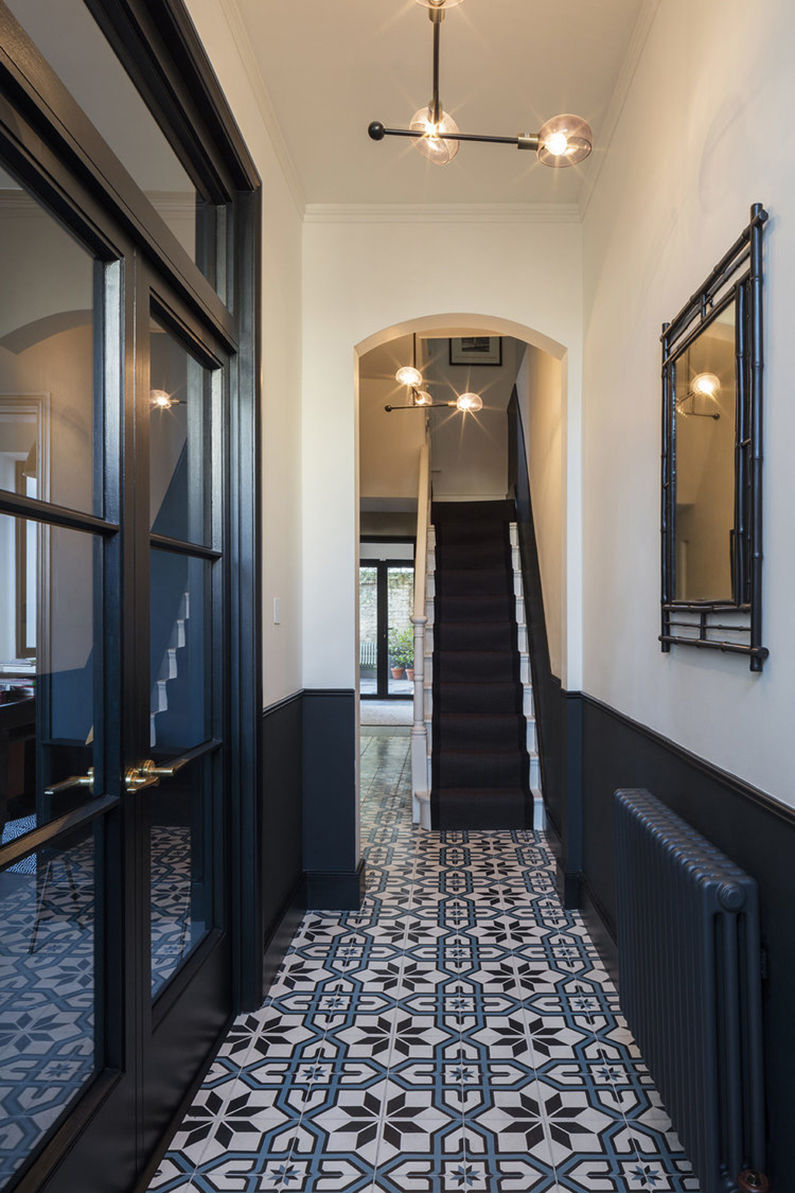
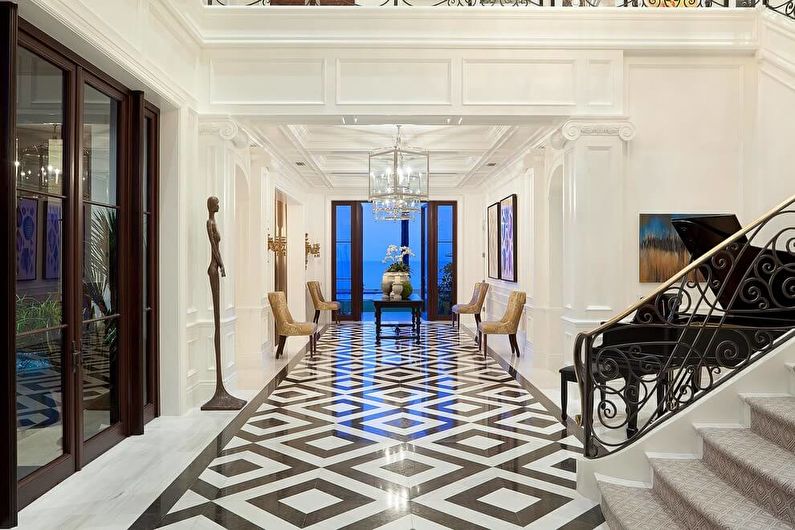
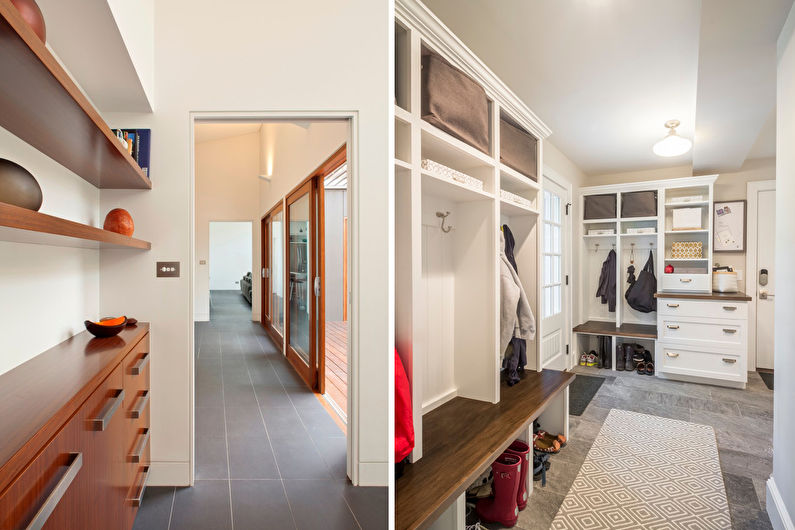

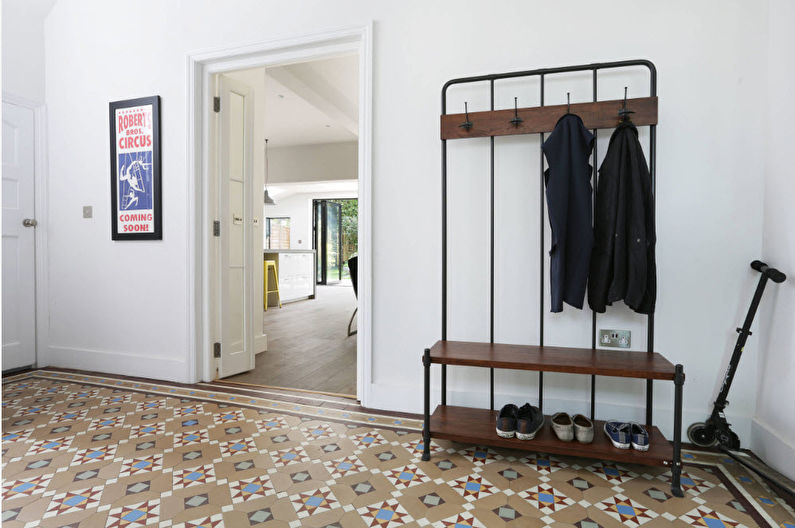
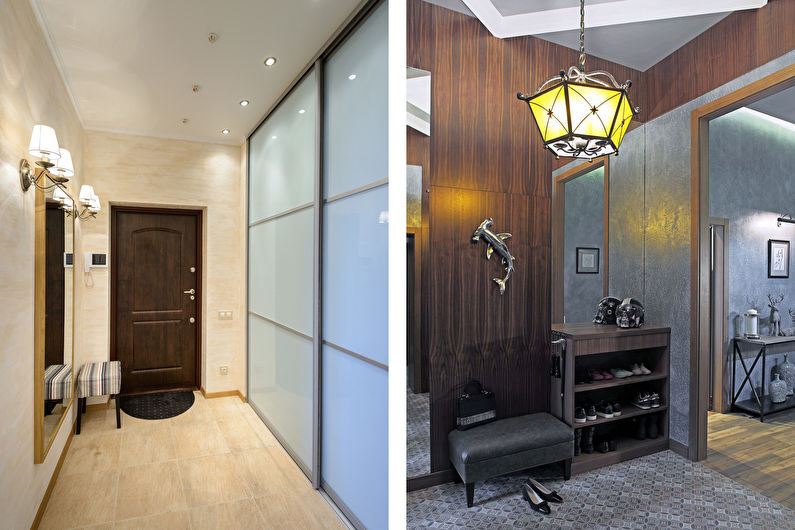

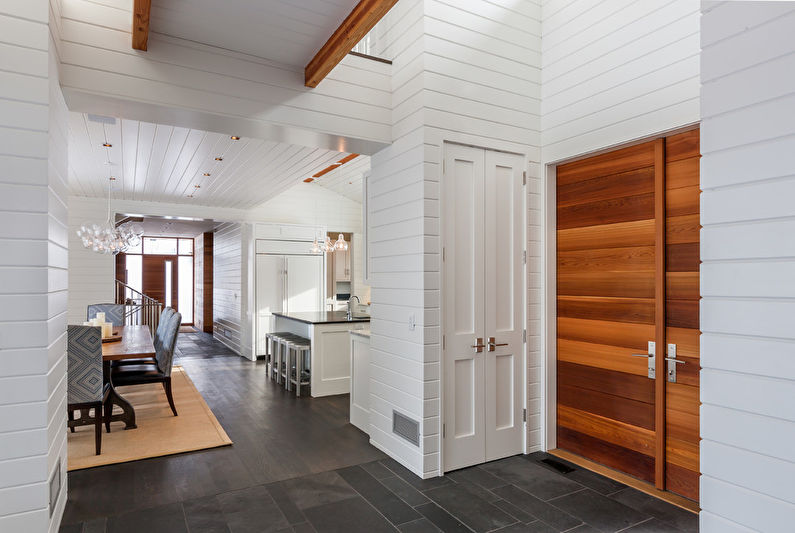
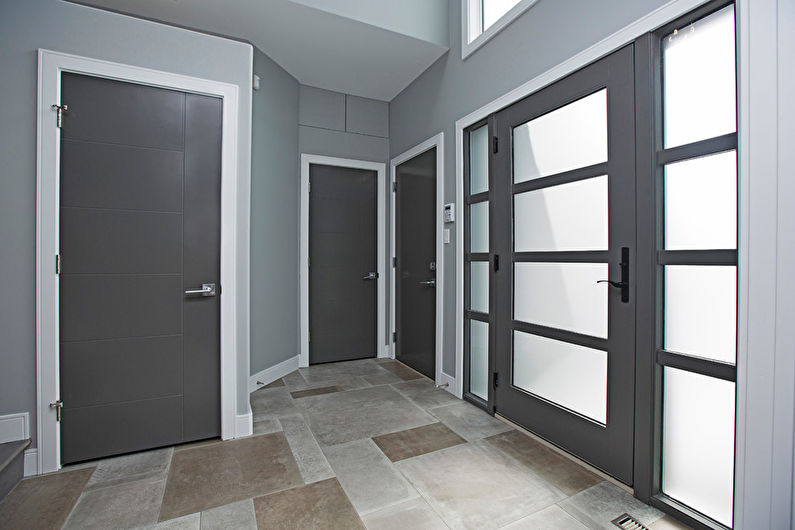
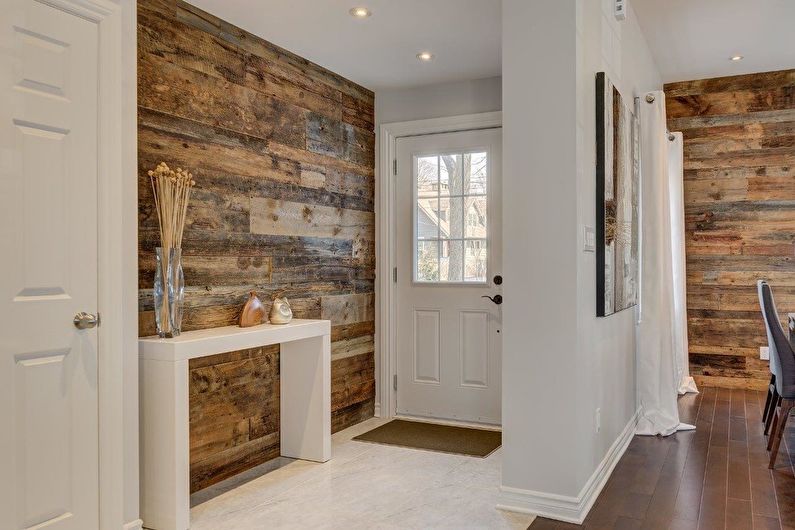
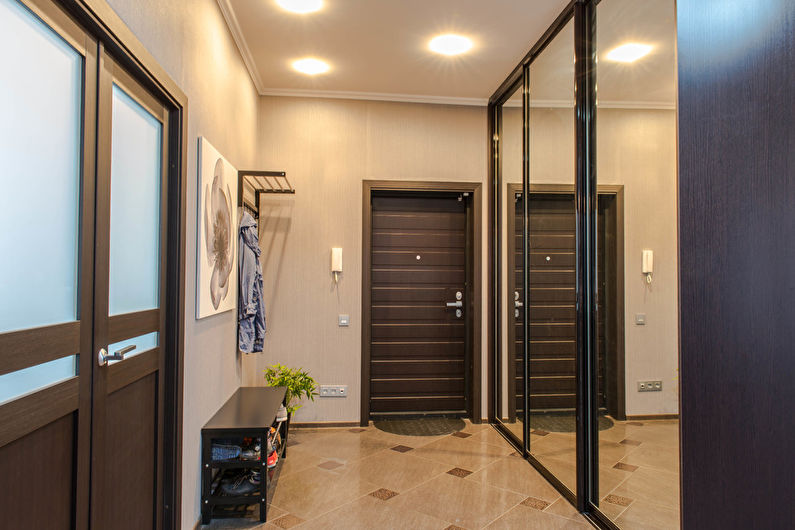
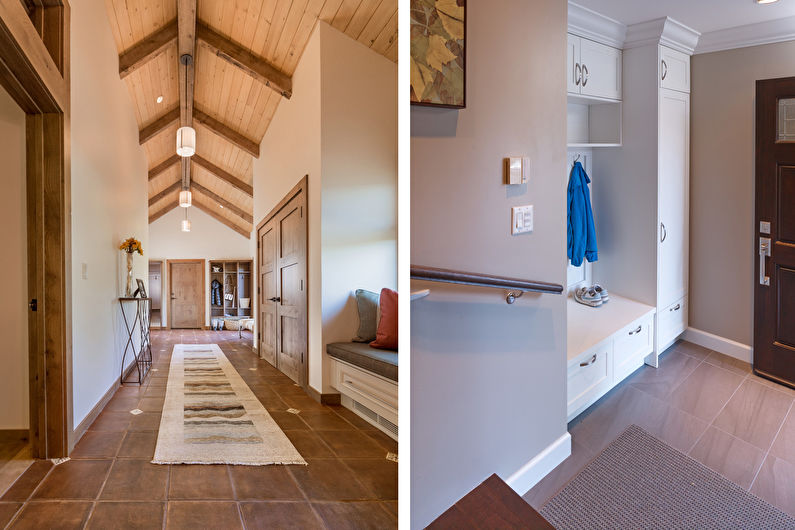
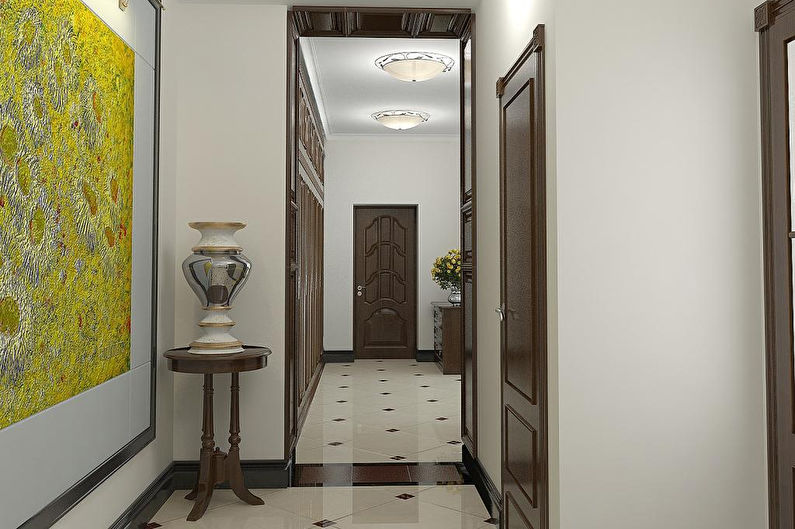
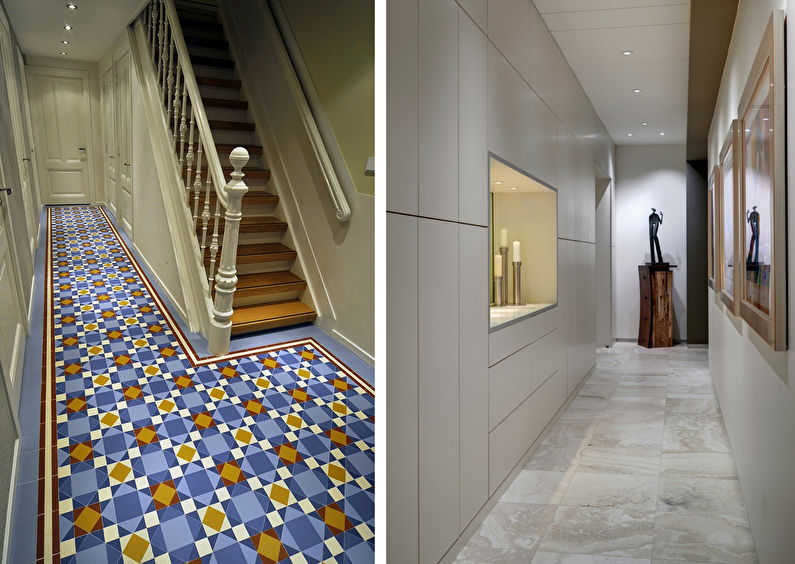

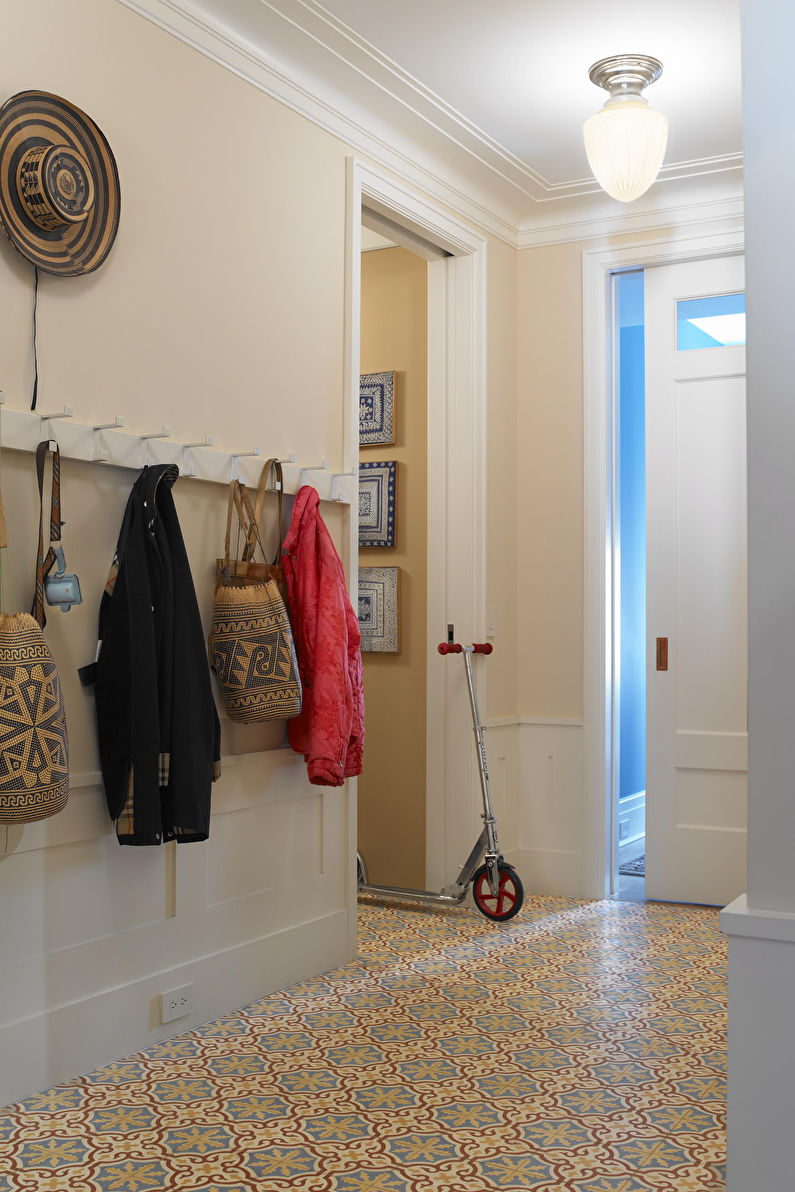
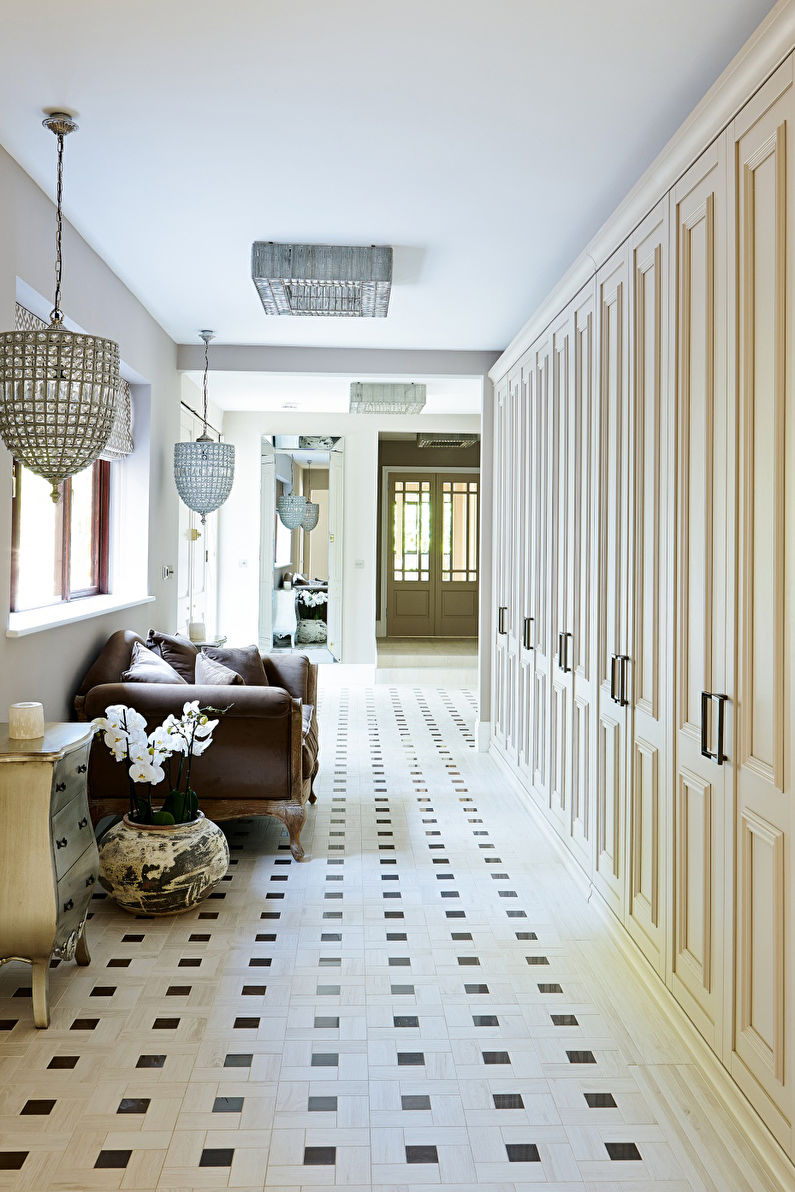
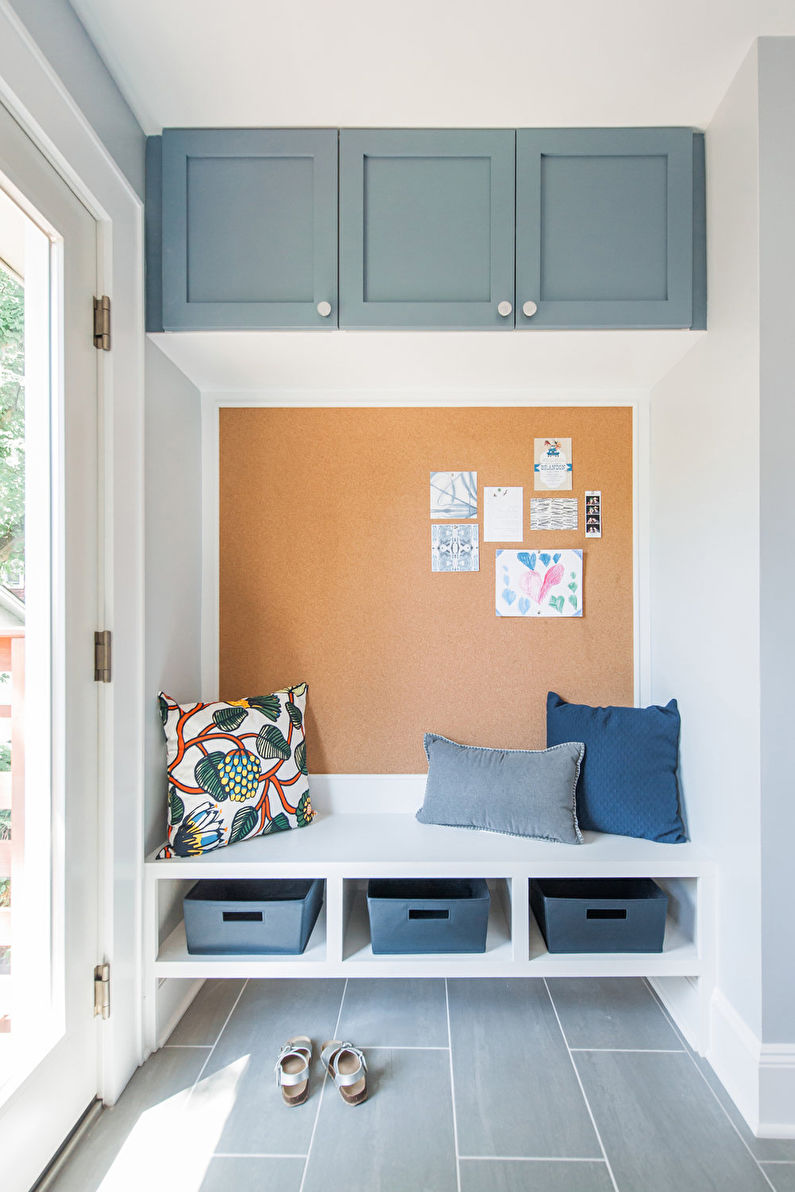
Video: Hallway Floor Tiles - Design Ideas
